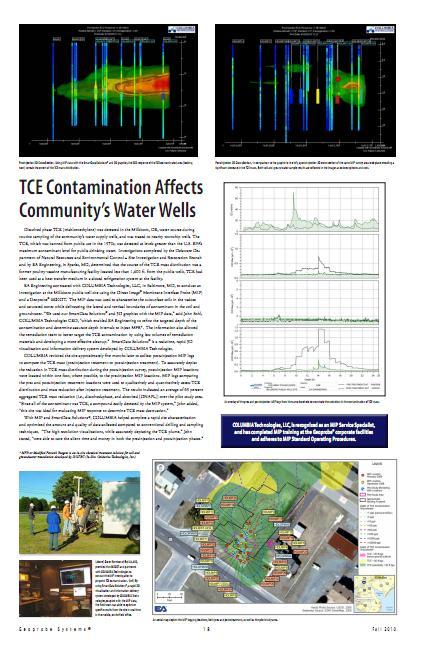Article originally featured in the Probing Times, the official newsletter of Geoprobe Systems® Fall 2010 Issue
Dissolved phase TCE (trichloroethylene) was detected in the Millsboro, DE, water source during routine sampling of the community's water supply wells, and was traced to nearby township wells. The TCE, which was banned from public use in the 1970s, was detected at levels greater than the U.S. EPA's maximum contaminant level for public drinking water. Investigations completed by the Delaware Department of Natural Resources and Environmental Control – Site Investigation and Restoration Branch and by EA Engineering, in Sparks, MD, determined that the source of the TCE mass distribution was a former poultry vaccine manufacturing facility located less than 1,400 ft. from the public wells. TCE had been used as a heat transfer medium in a closed refrigeration system at the facility.
EA Engineering contracted with COLUMBIA Technologies, LLC, in Baltimore, MD, to conduct an investigation at the Millsboro public well site using the Direct Image® Membrane Interface Probe and a Geoprobe® 6620DT. The MIP data was used to characterize the subsurface soils in the vadose and saturated zones while delineating the lateral and vertical boundaries of contaminant in the soil and groundwater. "We used our SmartData Solutions® and 3D graphics with the MIP data," said John Sohl, COLUMBIA Technologies CEO, "which enabled EA Engineering to refine the targeted depth of the contamination and determine accurate depth intervals to inject MFR. The information also allowed the remediation team to better target the TCE contamination by using less volumes of remediation materials and developing a more effective cleanup." SmartData Solutions® is a real-time, rapid 3D visualizations and information delivery system developed by COLUMBIA Technologies.
COLUMBIA revisited the site approximately five months later to collect post-injection MIP logs to compare the TCE mass (pre-injection treatment to post-injection treatment). To accurately depict the reduction in TCE mass distribution during the post-injection survey, post-injection MIP locations were located within one foot, where possible, to the pre-injection MIP locations. MIP logs comparing the pre- and post-injection treatment locations were used to qualitatively and quantitatively assess TCE distribution and mass reduction after injection treatment. The results indicated an average of 69 percent aggregated TCE mass reduction (i.e., dissolved-phase, and absorbed [DNAPL]) over the pilot study area. "Since all of the contaminant was TCE, a compound easily detected by the MIP system," John added, "this site was ideal for evaluating MIP response to determine TCE mass destruction."
With MIP and SmartData Solutions®, COLUMBIA helped complete a rapid site characterization and optimized the amount and quality of data collected compared to conventional drilling and sampling techniques. "The high resolution visualizations, while accurately depicting the TCE plume," John stated, "were able to save the client time and money in both the pre-injection and post-injection phases."
Read the full article by viewing the Fall 2010 issue of the Probing Times, the official newsletter of Geoprobe Systems®.


